Heavy Mineral and Zircon Age Constraints on Provenance of Cenozoic Sandstones in the Gulf of Mexico Subsurface
Abstract
:1. Introduction
2. Analytical Methods
2.1. Conventional (Petrographic) Heavy Mineral Analysis
2.2. Geochronology
3. Wilcox Group Sandstones
3.1. Heavy Mineral Data
3.2. Zircon Geochronology
3.3. Interpretation
4. Yegua Sandstones
4.1. Heavy Mineral Data
4.2. Zircon Geochronology
4.3. Interpretation
5. Miocene Sandstones
5.1. Heavy Mineral Data
5.2. Zircon Geochronology
5.3. Interpretation
6. Conclusions
Supplementary Materials
Author Contributions
Funding
Data Availability Statement
Acknowledgments
Conflicts of Interest
References
- Galloway, W.E. Depositional evolution of the Gulf of Mexico sedimentary basin. In Sedimentary Basins of the World: Volume 5. The Sedimentary Basins of the United States and Canada; Miall, A.D., Ed.; Elsevier: Amsterdam, The Netherlands, 2008; pp. 505–549. [Google Scholar]
- Galloway, W.E.; Whiteaker, T.L.; Ganey-Curry, P. History of Cenozoic North American drainage basin evolution, sediment yield, and accumulation in the Gulf of Mexico basin. Geosphere 2011, 7, 938–973. [Google Scholar] [CrossRef]
- Snedden, J.W.; Galloway, W.E. The Gulf of Mexico Sedimentary Basin: Depositional Evolution and Petroleum Applications; Cambridge University Press: Cambridge, UK, 2019. [Google Scholar]
- Craddock, W.H.; Kylander-Clark, A.R.C. U-Pb ages of detrital zircons from the Tertiary Mississippi River Delta in central Louisiana: Insights into sediment provenance. Geosphere 2013, 9, 1832–1851. [Google Scholar] [CrossRef]
- Bornhauser, M. Heavy mineral associations in Quaternary and late Tertiary sediments of the Gulf Coast of Louisiana and Texas. J. Sediment. Petrol. 1940, 10, 125–135. [Google Scholar] [CrossRef]
- Cogen, W.M. Heavy-mineral zones of Louisiana and Texas Gulf Coast sediments. Am. Assoc. Pet. Geol. Bull. 1940, 24, 2069–2101. [Google Scholar]
- Goldstein, A., Jr. Sedimentary petrologic provinces of the northern Gulf of Mexico. J. Sediment. Petrol. 1942, 12, 77–84. [Google Scholar]
- Hsu, J.K. Texture and mineralogy of the recent sands of the Gulf Coast. J. Sediment. Petrol. 1960, 30, 380–403. [Google Scholar]
- Bramlette, M.N. The stability of minerals in sandstone. J. Sediment. Petrol. 1941, 11, 32–36. [Google Scholar] [CrossRef]
- Mange, M.A.; Otvos, E.G. Gulf coastal plain evolution in west Louisiana: Heavy mineral provenance and Pleistocene alluvial chronology. Sediment. Geol. 2005, 182, 29–57. [Google Scholar] [CrossRef]
- Milliken, K.L. Loss of provenance information through subsurface diagenesis in Plio-Pleistocene sandstones, northern Gulf of Mexico. J. Sediment. Petrol. 1988, 58, 992–1002. [Google Scholar]
- Milliken, K.L. Provenance and diagenesis of heavy minerals, Cenozoic units of the northwestern Gulf of Mexico sedimentary basin. Dev. Sedimentol. 2007, 58, 247–261. [Google Scholar]
- Fedo, C.M.; Sircombe, K.N.; Rainbird, R.H. Detrital zircon analysis of the sedimentary record. Rev. Mineral. Geochem. 2003, 53, 277–303. [Google Scholar] [CrossRef]
- Dickinson, W.R.; Gehrels, G.E. U-Pb ages of detrital zircons in Jurassic eolian and associated sandstones of the Colorado Plateau: Evidence for transcontinental dispersal and intraregional recycling of sediment. Geol. Soc. Am. Bull. 2009, 121, 408–433. [Google Scholar] [CrossRef]
- Hutto, A.P.; Yancey, T.E.; Miller, B.V. Provenance of Paleocene–Eocene Wilcox Group sediments in Texas: The evidence from detrital zircons. Gulf Coast Assoc. Geol. Soc. Trans. 2009, 59, 357–362. [Google Scholar]
- Lawton, T.F.; Bradford, I.A.; Vega, F.J.; Gehrels, G.E.; Amato, J.M. Provenance of Upper Cretaceous-Paleogene sandstones in the foreland basin system of the Sierra Madre Oriental, northeastern Mexico, and its bearing on fluvial dispersal systems of the Mexican Laramide Province. Geol. Soc. Am. Bull. 2009, 121, 820–836. [Google Scholar] [CrossRef]
- Mackey, G.N.; Horton, B.K.; Milliken, K.L. Provenance of the Paleocene-Eocene Wilcox Group, western Gulf of Mexico basin: Evidence for integrated drainage of the southern Laramide Rocky Mountains and Cordilleran arc. Geol. Soc. Am. Bull. 2012, 124, 1007–1024. [Google Scholar] [CrossRef]
- Blum, M.; Pecha, M.E. Mid-Cretaceous to Paleocene North American drainage reorganization from detrital zircons. Geology 2014, 42, 607–610. [Google Scholar] [CrossRef]
- Wahl, P.J.; Yancey, T.E.; Pope, M.C.; Miller, B.V.; Ayers, W.B. U-Pb detrital zircon geochronology of the Upper Paleocene to Lower Eocene Wilcox Group, east-central Texas. Geosphere 2016, 12, 1517–1531. [Google Scholar] [CrossRef]
- Blum, M.D.; Milliken, K.T.; Pecha, M.A.; Snedden, J.W.; Frederick, B.C.; Galloway, W.E. Detrital-zircon records of Cenomanian, Paleocene, and Oligocene Gulf of Mexico drainage integration and sediment routing: Implications for scales of basin-floor fans. Geosphere 2017, 13, 2169–2205. [Google Scholar] [CrossRef]
- Snedden, J.W.; Tinker, L.D.; Virdell, J. Southern Gulf of Mexico Wilcox source to sink: Investigating and predicting Paleogene Wilcox reservoirs in eastern Mexico deep-water areas. Bull. Am. Assoc. Pet. Geol. 2018, 102, 2045–2074. [Google Scholar] [CrossRef]
- Sharman, G.R.; Covault, J.A.; Stockli, D.F.; Wroblewski, A.F.-J.; Bush, M.A. Early Cenozoic drainage reorganization of the United States Western Interior—Gulf of Mexico sediment routing system. Geology 2016, 45, 187–190. [Google Scholar] [CrossRef]
- Xu, J.; Snedden, J.W.; Stockli, D.F.; Fulthorpe, C.S.; Galloway, W.E. Early Miocene continental-scale sediment supply to the Gulf of Mexico Basin based on detrital zircon analysis. Geol. Soc. Am. Bull. 2017, 129, 3–22. [Google Scholar] [CrossRef]
- Iizuka, T.; Hirata, T.; Komiya, T.; Rino, S.; Katayama, I.; Motoki, A.; Maruyama, S. U-Pb and Lu-Hf isotope systematics of zircons from the Mississippi River sand: Implications for reworking and growth of continental crust. Geology 2005, 33, 485–488. [Google Scholar] [CrossRef]
- Fildani, A.; McKay, M.P.; Stockli, D.; Clark, J.; Dykstra, M.L.; Stockli, L.; Hessler, A.M. The ancestral Mississippi drainage archived in the late Wisconsin Mississippi deep-sea fan. Geology 2016, 44, 479–482. [Google Scholar] [CrossRef]
- Giles, K.D.; Jackson, W.T., Jr.; McKay, M.P.; Beebe, D.A.; Larsen, D.; Kwon, Y.; Shaulis, B. Sediment input, alongshore transport, and coastal mixing in the northeastern Gulf of Mexico based on detrital-zircon geochronology. Mar. Pet. Geol. 2023, 148, 105997. [Google Scholar] [CrossRef]
- Lawton, T.F.; Juárez-Arriaga, E.; Stockli, D.F.; Fildani, A. Modern sand provenance and transport across the western Gulf of Mexico margin. Geol. Soc. Am. Bull. 2024, 136, 1127–1150. [Google Scholar] [CrossRef]
- Hessler, A.M.; Covault, J.A.; Stockli, D.F.; Fildani, A. Late Cenozoic cooling favored glacial over tectonic controls on sediment supply to the western Gulf of Mexico. Geology 2018, 46, 995–998. [Google Scholar] [CrossRef]
- Masalimova, L.; Falivene, O.; Lawler, T.; Ichaso, A.; Jaminski, M.; Ozkan, A.; Jackett, S.; McDonald, M.; Frascati, A.; Morton, A.; et al. Sediment dispersal pattern of the Paleogene Wilcox Formation in the deep-water Gulf of Mexico Basin based on detrital zircon analysis and forward modelling. In Proceedings of the AAPG Annual Convention and Exhibition, Houston, TX, USA, 5 April 2017. [Google Scholar]
- Xu, J.; Snedden, J.W.; Fulthorpe, J.S.; Stockli, D.F.; Galloway, W.E.; Sickmann, Z.T. Quantifying the relative contributions of Miocene rivers to the deep Gulf of Mexico using detrital zircon geochronology: Implications for the evolution of Gulf Basin circulation and regional drainage. Basin Res. 2022, 34, 1143–1163. [Google Scholar] [CrossRef]
- Morton, A.C.; Hallsworth, C.R. Identifying provenance-specific features of detrital heavy mineral assemblages in sandstones. Sediment. Geol. 1994, 90, 241–256. [Google Scholar] [CrossRef]
- Allen, P.A. From landscape into geological history. Nature 2008, 45, 274–276. [Google Scholar] [CrossRef]
- Galehouse, J.S. Point-counting. In Procedures in Sedimentary Petrology; Carver, R.E., Ed.; Wiley-Interscience: New York, NY, USA, 1971; pp. 385–407. [Google Scholar]
- Mange, M.A.; Maurer, H.F.W. Heavy Minerals in Colour; Chapman and Hall: London, UK, 1992. [Google Scholar]
- Williams, I.S. U-Th-Pb geochronology by ion microprobe. In Applications of Microanalytical Techniques to Understanding Mineralizing Processes; Reviews in Economic, Geology; McKibben, M.A., Shanks, W.C.P., Ridley, W.I., Eds.; GeoscienceWorld: Mclean, VA, USA, 1998; Volume 7, pp. 1–35. [Google Scholar]
- Ludwig, K.R. SQUID 1.02, A User’s Manual; Berkeley Geochronology Center Special Publication: Berkeley, CA, USA, 2001; Volume 2. [Google Scholar]
- Tera, F.; Wasserburg, G. U-Th-Pb systematics in three Apollo 14 basalts and the problem of initial Pb in lunar rocks. Earth Planet. Sci. Lett. 1972, 14, 281–304. [Google Scholar] [CrossRef]
- Sircombe, K.N. AgeDisplay: An EXCEL workbook to evaluate and display univariate geochronological data using binned frequency histograms and probability density distributions. Comput. Geosci. 2004, 30, 21–31. [Google Scholar] [CrossRef]
- Morton, A.C.; Hallsworth, C.R. Stability of detrital heavy minerals during burial diagenesis. Dev. Sedimentol. 2007, 58, 215–245. [Google Scholar]
- Morton, A.C. Value of heavy minerals in sediments and sedimentary rocks for provenance, transport history and stratigraphic correlation. In Quantitative Mineralogy and Microanalysis of Sediments and Sedimentary Rocks; Mineralogical Association of Canada Short Course, Series; Sylvester, P., Ed.; GeoscienceWorld: Mclean, VA, USA, 2012; Volume 42, pp. 133–165. [Google Scholar]
- Andò, S.; Garzanti, E.; Padoan, M.; Limonta, M. Corrosion of heavy minerals during weathering and diagenesis: A catalog for optical analysis. Sediment. Geol. 2014, 280, 165–178. [Google Scholar] [CrossRef]
- McBride, E.F.; Diggs, T.N.; Wilson, J.C. Compaction of Wilcox and Carrizo sandstones (Paleocene-Eocene) to 4420 m, Texas Gulf Coast. J. Sediment. Petrol. 1991, 61, 73–85. [Google Scholar]
- Galloway, W.E.; Liu, X.; Travis-Neuberger, D.; Xue, L. Reference High Resolution Correlation Cross Sections, Paleogene Section, Texas Coastal Plain; Bureau of Economic Geology: Austin, TX, USA, 1994; 19p. [Google Scholar]
- Meinhold, G. Rutile and its applications in earth sciences. Earth-Sci. Rev. 2010, 102, 1–28. [Google Scholar] [CrossRef]
- O’Sullivan, G.J.; Chew, D.M.; Morton, A.C.; Mark, C.; Henrichs, I.A. An integrated apatite geochronology and geochemistry tool for sedimentary provenance analysis. Geochem. Geophys. Geosyst. 2018, 19, 1309–1326. [Google Scholar] [CrossRef]
- Dickinson, W.R.; Gehrels, G.E. Use of U-Pb ages of detrital zircons to infer maximum depositional ages of strata: A test against a Colorado Plateau Mesozoic database. Earth Planet. Sci. Lett. 2009, 288, 115–125. [Google Scholar] [CrossRef]
- Rivers, T. Assembly and preservation of lower, mid, and upper orogenic crust in the Grenville Province—Implications for the evolution of large hot long-duration orogens. Precambrian Res. 2008, 167, 237–259. [Google Scholar] [CrossRef]
- Hurst, A.; Morton, A. Provenance models: The role of sandstone mineral-chemical stratigraphy. In Sediment Provenance Studies in Hydrocarbon Exploration and Production; Scott, R.A., Smyth, H., Morton, A., Richardson, N., Eds.; Geological Society of London, Special Publication: London, UK, 2014; Volume 386, pp. 7–26. [Google Scholar]
- Morton, A.; McGill, P. Correlation of hydrocarbon reservoir sandstones using heavy mineral provenance signatures: Examples from the North Sea and adjacent areas. Minerals 2018, 8, 564. [Google Scholar] [CrossRef]
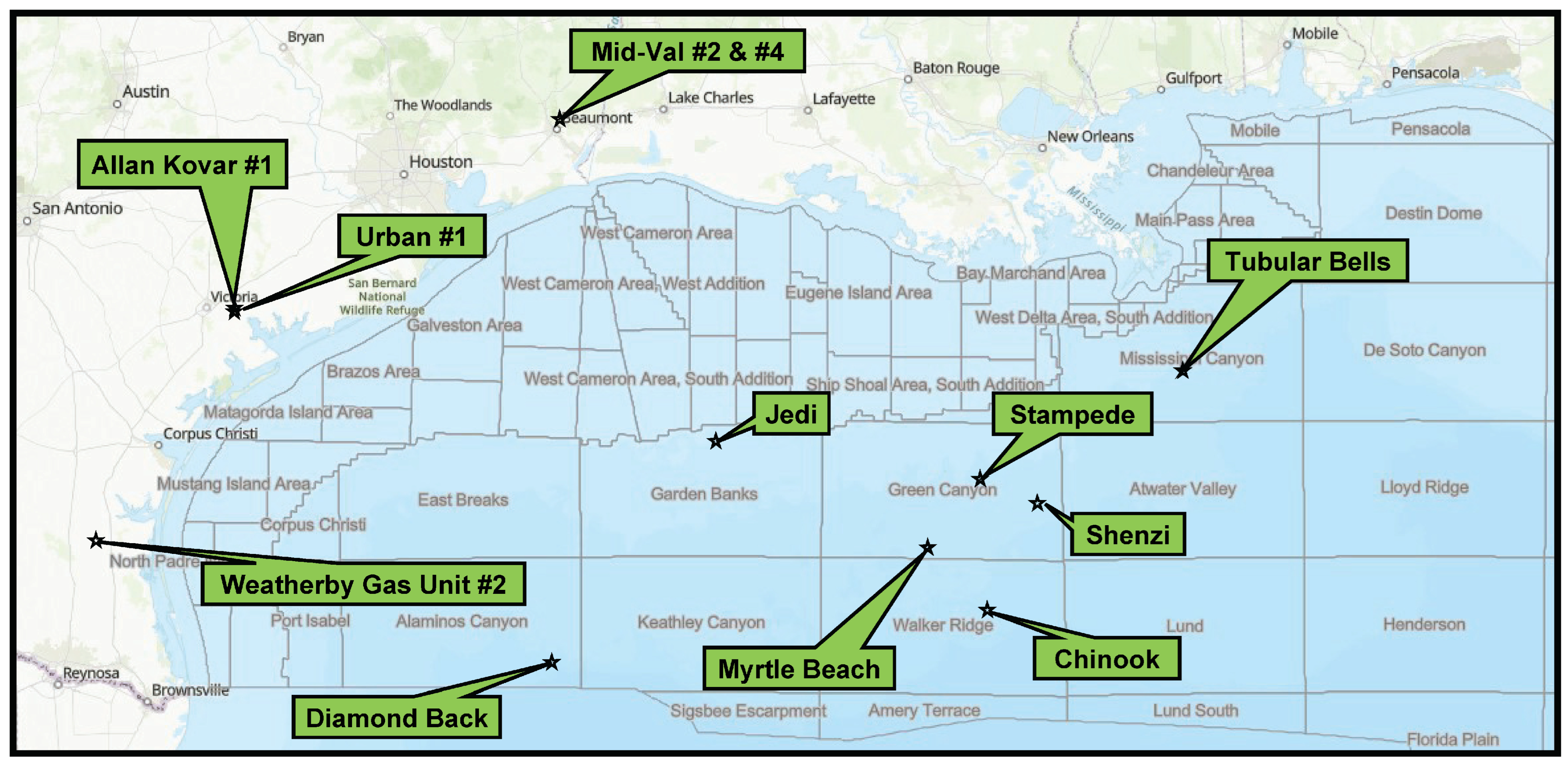
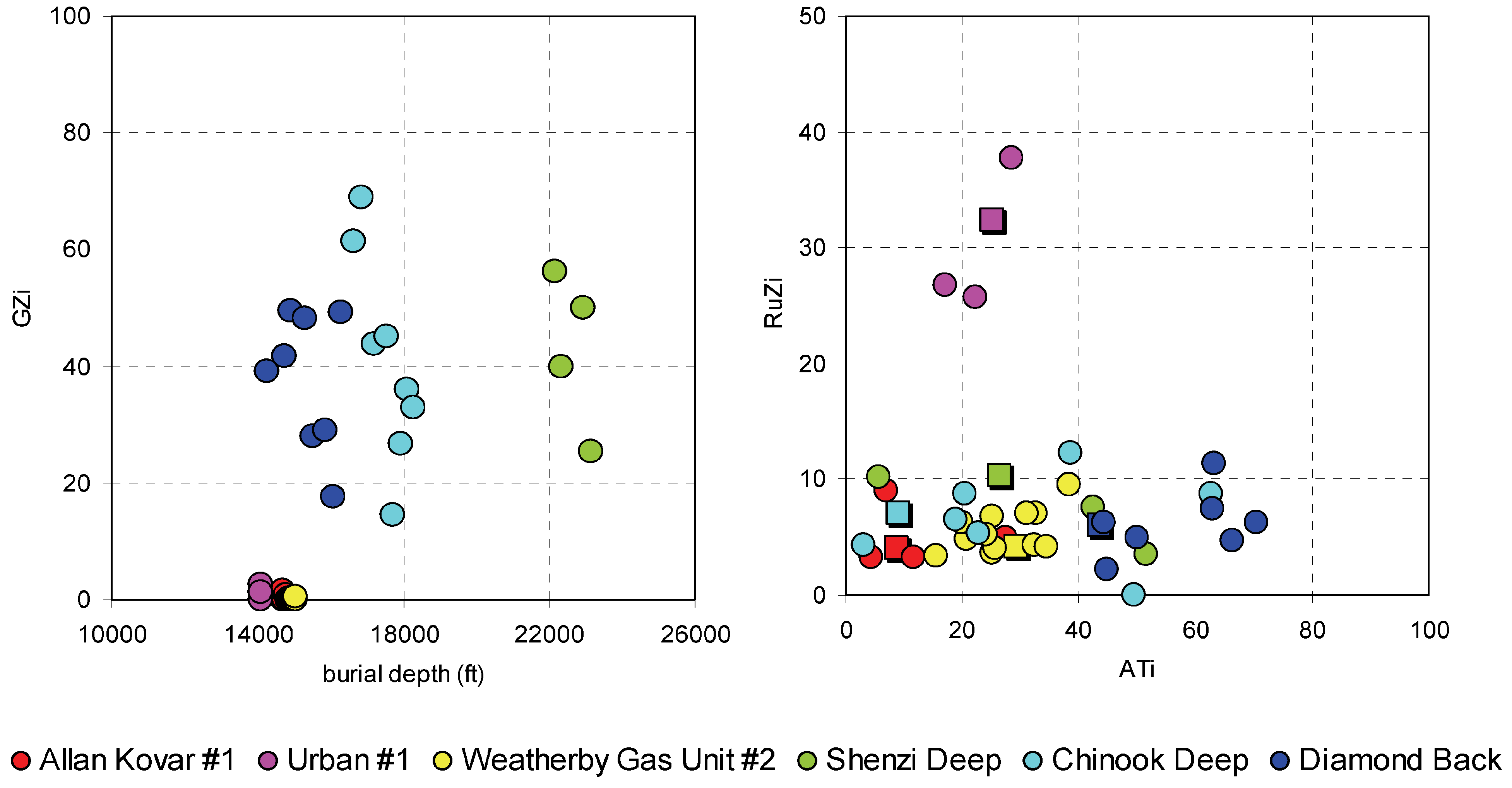

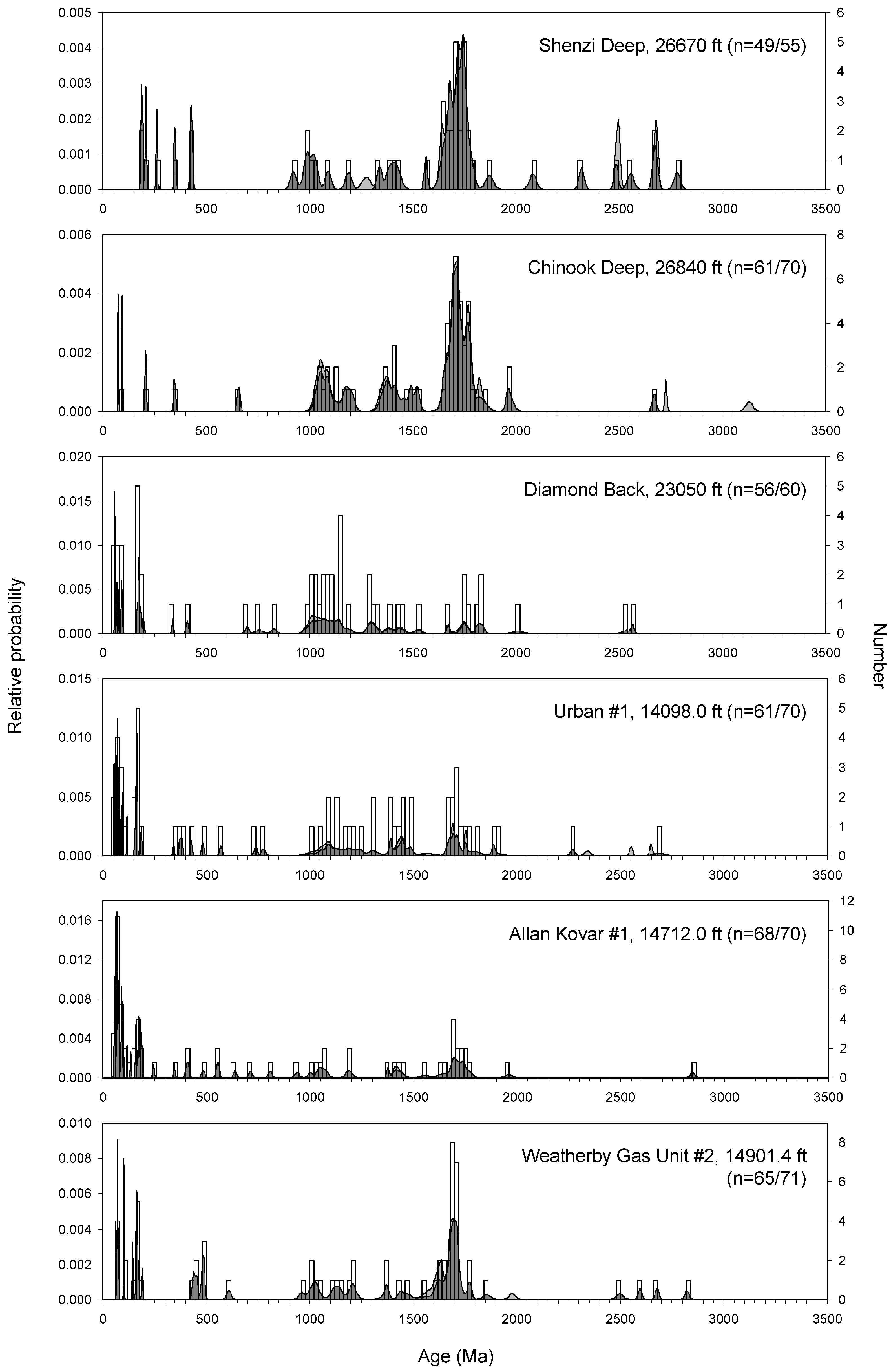
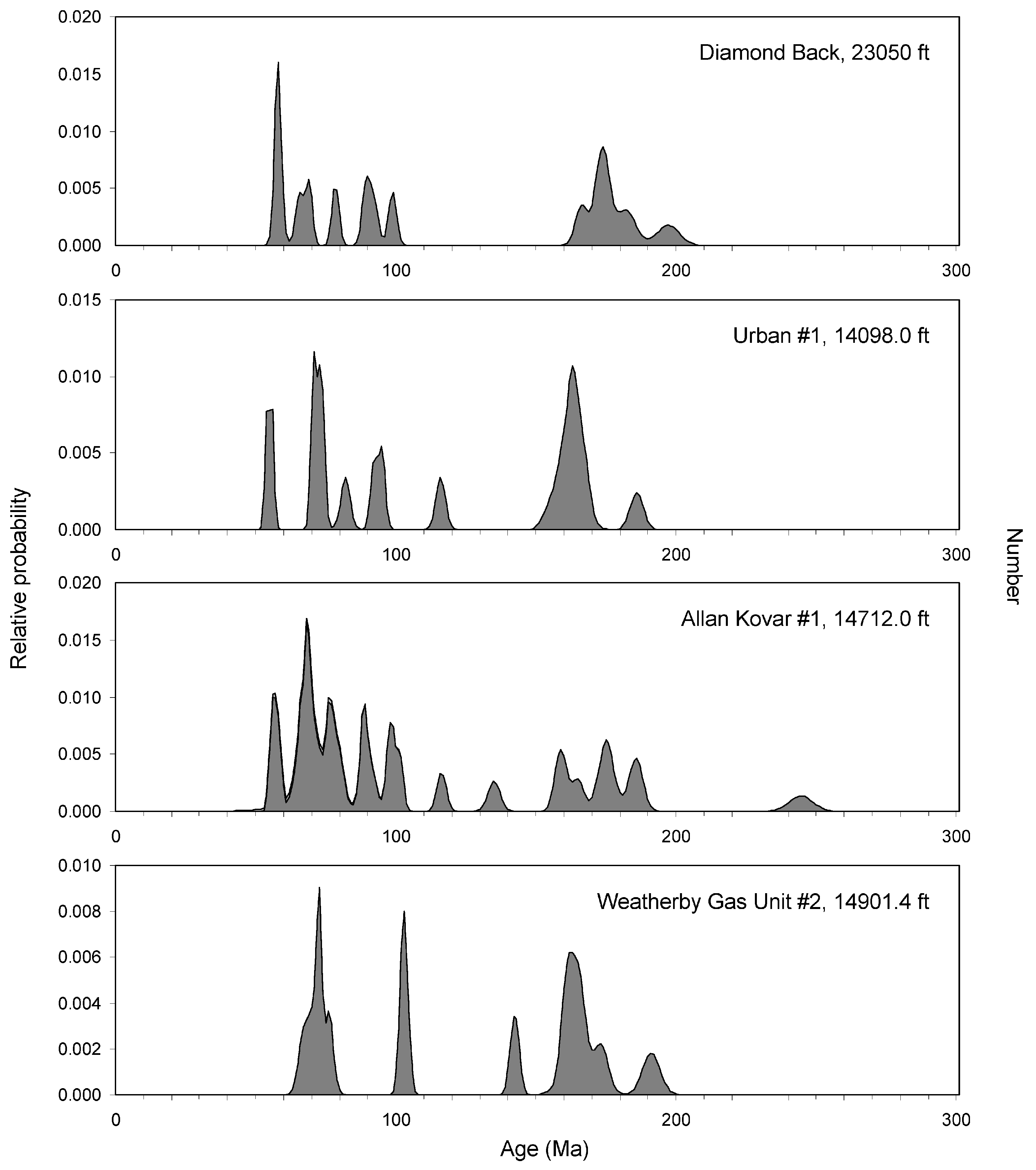


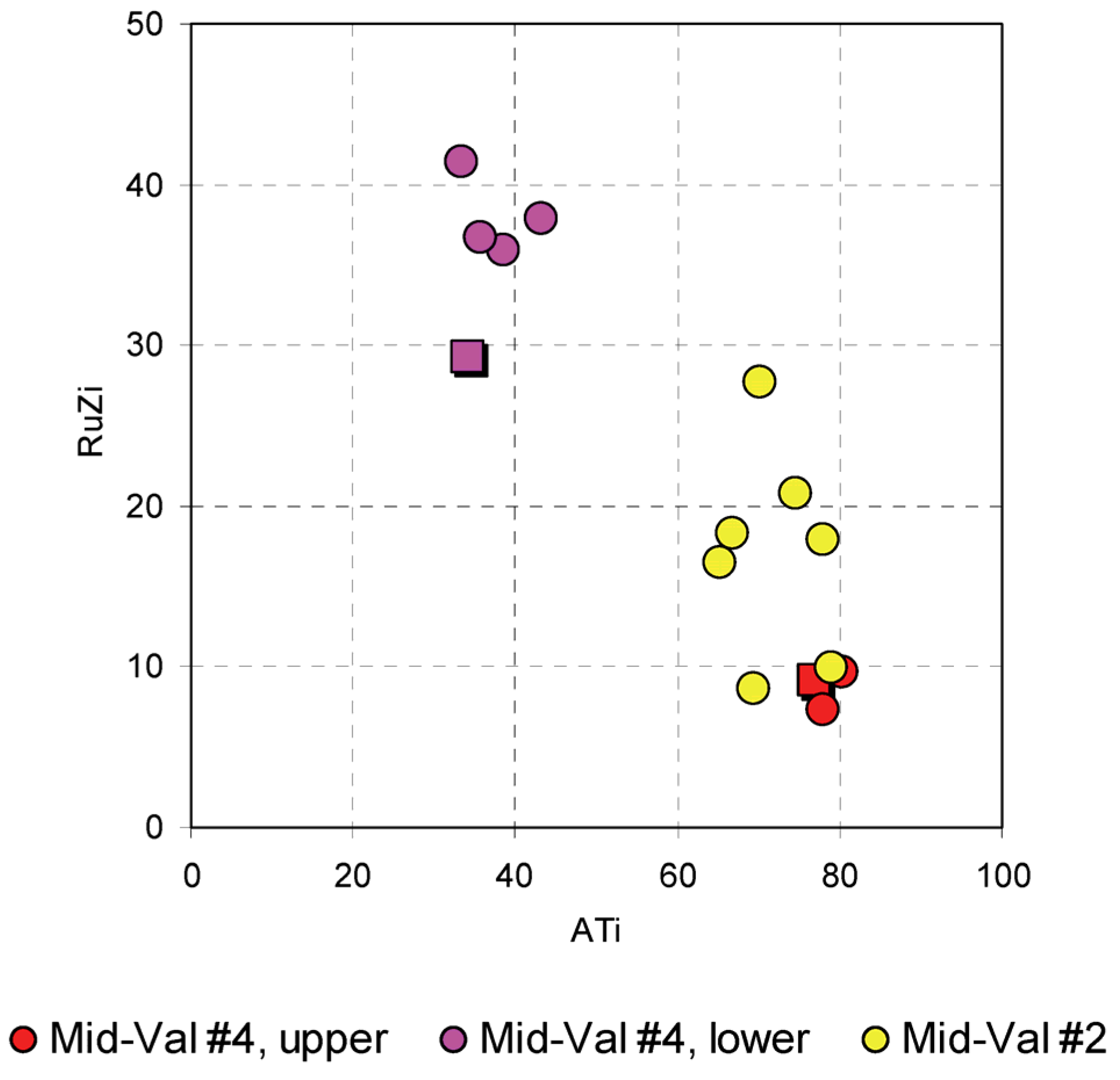
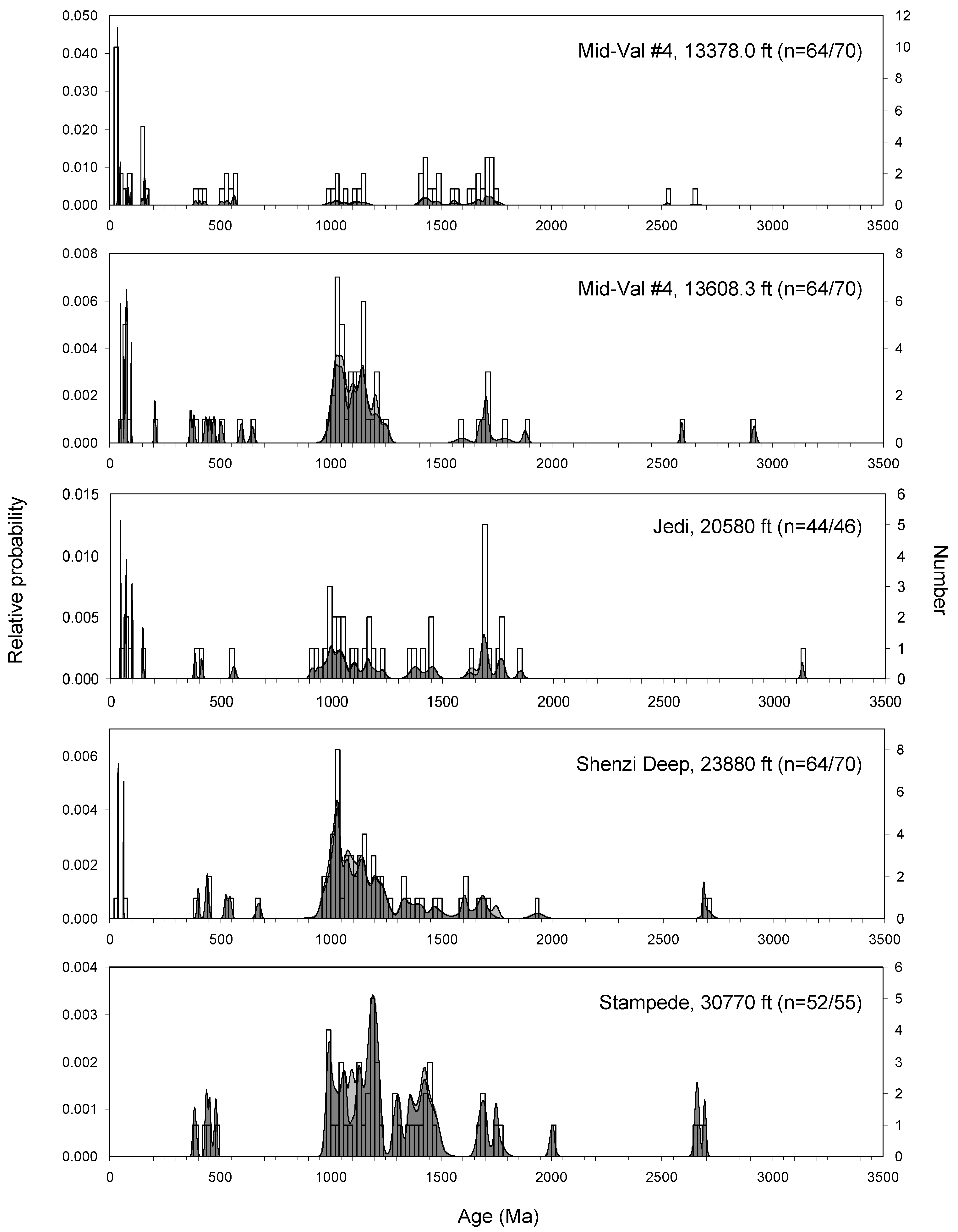
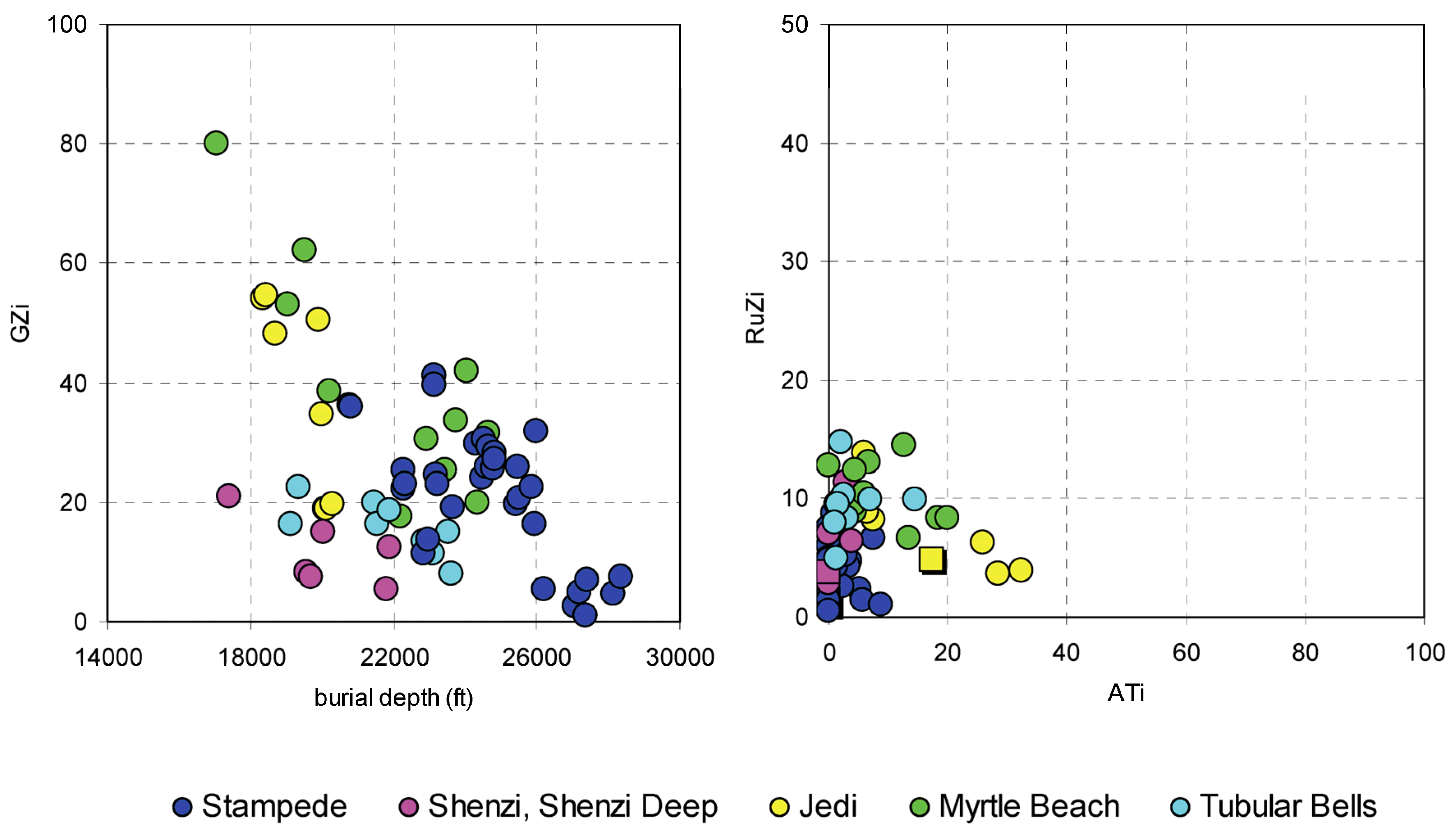
Disclaimer/Publisher’s Note: The statements, opinions and data contained in all publications are solely those of the individual author(s) and contributor(s) and not of MDPI and/or the editor(s). MDPI and/or the editor(s) disclaim responsibility for any injury to people or property resulting from any ideas, methods, instructions or products referred to in the content. |
© 2024 by the authors. Licensee MDPI, Basel, Switzerland. This article is an open access article distributed under the terms and conditions of the Creative Commons Attribution (CC BY) license (https://creativecommons.org/licenses/by/4.0/).
Share and Cite
Morton, A.C.; Strickler, M.E.; Fanning, C.M. Heavy Mineral and Zircon Age Constraints on Provenance of Cenozoic Sandstones in the Gulf of Mexico Subsurface. Minerals 2024, 14, 779. https://doi.org/10.3390/min14080779
Morton AC, Strickler ME, Fanning CM. Heavy Mineral and Zircon Age Constraints on Provenance of Cenozoic Sandstones in the Gulf of Mexico Subsurface. Minerals. 2024; 14(8):779. https://doi.org/10.3390/min14080779
Chicago/Turabian StyleMorton, Andrew C., Michael E. Strickler, and C. Mark Fanning. 2024. "Heavy Mineral and Zircon Age Constraints on Provenance of Cenozoic Sandstones in the Gulf of Mexico Subsurface" Minerals 14, no. 8: 779. https://doi.org/10.3390/min14080779





